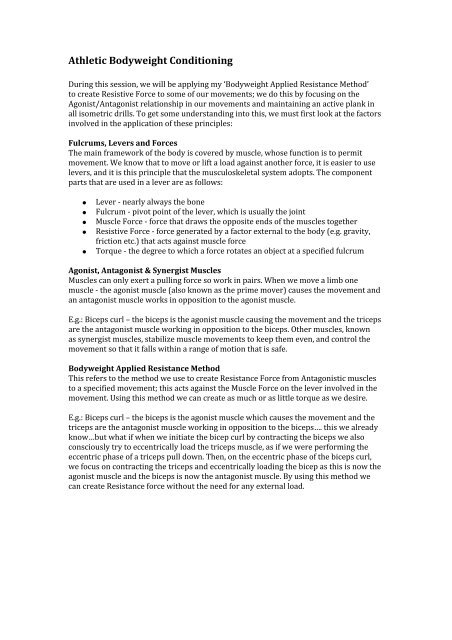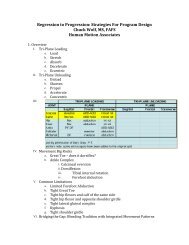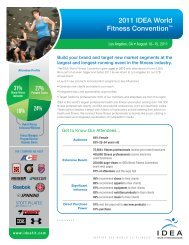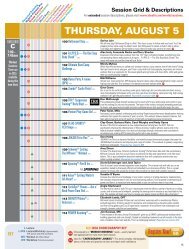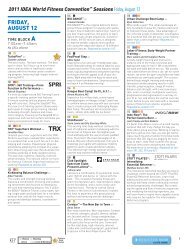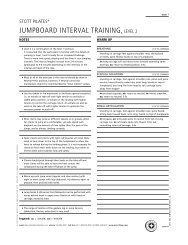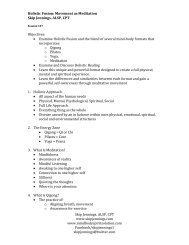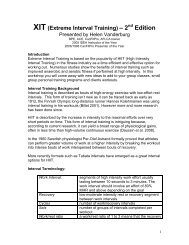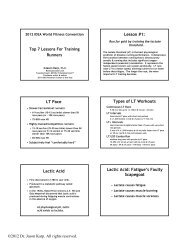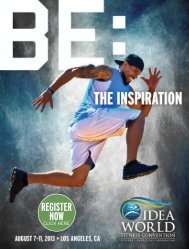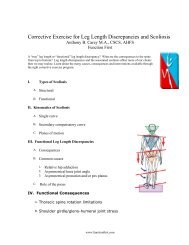Athletic Bodyweight Conditioning - Idea
Athletic Bodyweight Conditioning - Idea
Athletic Bodyweight Conditioning - Idea
Create successful ePaper yourself
Turn your PDF publications into a flip-book with our unique Google optimized e-Paper software.
<strong>Athletic</strong> <strong>Bodyweight</strong> <strong>Conditioning</strong>During this session, we will be applying my ‘<strong>Bodyweight</strong> Applied Resistance Method’to create Resistive Force to some of our movements; we do this by focusing on theAgonist/Antagonist relationship in our movements and maintaining an active plank inall isometric drills. To get some understanding into this, we must first look at the factorsinvolved in the application of these principles:Fulcrums, Levers and ForcesThe main framework of the body is covered by muscle, whose function is to permitmovement. We know that to move or lift a load against another force, it is easier to uselevers, and it is this principle that the musculoskeletal system adopts. The componentparts that are used in a lever are as follows:●●●●●Lever - nearly always the boneFulcrum - pivot point of the lever, which is usually the jointMuscle Force - force that draws the opposite ends of the muscles togetherResistive Force - force generated by a factor external to the body (e.g. gravity,friction etc.) that acts against muscle forceTorque - the degree to which a force rotates an object at a specified fulcrumAgonist, Antagonist & Synergist MusclesMuscles can only exert a pulling force so work in pairs. When we move a limb onemuscle - the agonist muscle (also known as the prime mover) causes the movement andan antagonist muscle works in opposition to the agonist muscle.E.g.: Biceps curl – the biceps is the agonist muscle causing the movement and the tricepsare the antagonist muscle working in opposition to the biceps. Other muscles, knownas synergist muscles, stabilize muscle movements to keep them even, and control themovement so that it falls within a range of motion that is safe.<strong>Bodyweight</strong> Applied Resistance MethodThis refers to the method we use to create Resistance Force from Antagonistic musclesto a specified movement; this acts against the Muscle Force on the lever involved in themovement. Using this method we can create as much or as little torque as we desire.E.g.: Biceps curl – the biceps is the agonist muscle which causes the movement and thetriceps are the antagonist muscle working in opposition to the biceps…. this we alreadyknow…but what if when we initiate the bicep curl by contracting the biceps we alsoconsciously try to eccentrically load the triceps muscle, as if we were performing theeccentric phase of a triceps pull down. Then, on the eccentric phase of the biceps curl,we focus on contracting the triceps and eccentrically loading the bicep as this is now theagonist muscle and the biceps is now the antagonist muscle. By using this method wecan create Resistance force without the need for any external load.
<strong>Athletic</strong> <strong>Bodyweight</strong> <strong>Conditioning</strong> WorkoutWarm-upCalf raise and rotations. Single leg squat to shin touch. Leg hug andExtend. Figure 4 sit. Deep squat stomp. Cossacks. Good mornings. GolfSwings. Shoulder rolls. Scapular Pushups. Arm swings. Seal jacks.Integrated StrengthLay to standLunge to knee lift + holdOverhead squat windmillInverted shoulder pressHip Bridge switchBack to back squat sitMoving plankPlyometric/DynamicBeast plyo jumpsZombie flipsSprawl to standSpiderman climbSingle leg RDL to hopLocal Muscular EnduranceSplit lunge with lateral stepProne supermanPistol squatFlutter kick/with abductionHindi squat arm circleFace to face rowFunctional CoreHover to plankPartners pick up and hoverDonkey kickCrow to single leg extensionSide plank rotate and liftSquat and loaded crunchPlank to 90degree pointerFlexibility and MobilityRolling ball to Single hamstring/double hamstring. Long hip flexor with torsoTwist. Power bow. Pigeon to quad stretch. Figure 4 sit. Childs pose with lateralReach. Chest opener. Scapular release.Thank you for your attendance. Please find my contact info below.Brian CochraneWebsite: www.briancochrane.comEmail: info@briancochrane.comTwitter: @bri_cochraneFacebook: www.facebook.com/briancochranedotcom


